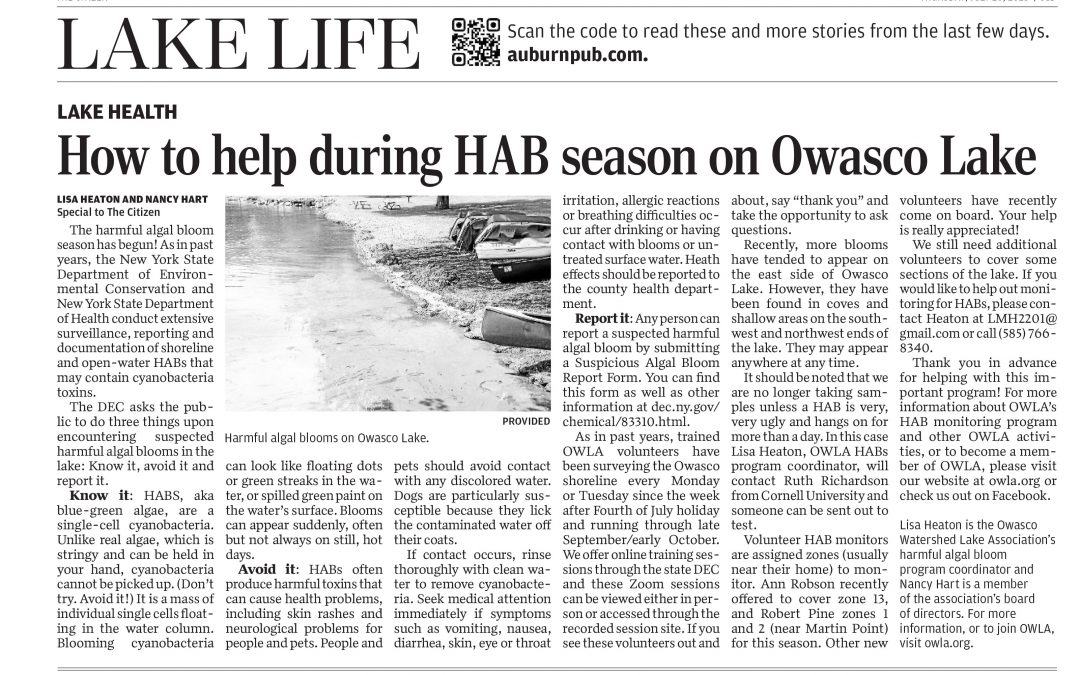How to help during HAB season on Owasco Lake
LISA HEATON AND NANCY HART
Special to The Citizen
The harmful algal bloom season has begun! As in past years, the New York State Department of Environmental Conservation and New York State Department of Health conduct extensive surveillance, reporting and documentation of shoreline and open-water HABs that may contain cyanobacteria toxins.
The DEC asks the public to do three things upon encountering suspected harmful algal blooms in the lake: Know it, avoid it and report it.
Know it: HABS, aka blue-green algae, are a single-cell cyanobacteria. Unlike real algae, which is stringy and can be held in your hand, cyanobacteria cannot be picked up. (Don’t try. Avoid it!) It is a mass of individual single cells floating in the water column. Blooming cyanobacteria can look like floating dots or green streaks in the water, or spilled green paint on the water’s surface. Blooms can appear suddenly, often but not always on still, hot days.
Avoid it: HABs often produce harmful toxins that can cause health problems, including skin rashes and neurological problems for people and pets. People and pets should avoid contact
with any discolored water. Dogs are particularly susceptible because they lick the contaminated water off their coats. If contact occurs, rinse thoroughly with clean water to remove cyanobacteria. Seek medical attention immediately if symptoms such as vomiting, nausea, diarrhea, skin, eye or throat irritation, allergic reactions or breathing difficulties occur after drinking or having contact with blooms or untreated surface water. Heath effects should be reported to the county health department.
Report it: Any person can report a suspected harmful algal bloom by submitting a Suspicious Algal Bloom Report Form. You can find this form as well as other information at dec.ny.gov/chemical/83310.html.
As in past years, trained OWLA volunteers have been surveying the Owasco shoreline every Monday or Tuesday since the week after Fourth of July holiday and running through late September/early October. We offer online training sessions through the state DEC and these Zoom sessions can be viewed either in person or accessed through the recorded session site. If you see these volunteers out and about, say “thank you” and take the opportunity to ask questions.
Recently, more blooms have tended to appear on the east side of Owasco Lake. However, they have been found in coves and hallow areas on the southwest and northwest ends of
the lake. They may appear anywhere at any time. It should be noted that we are no longer taking samples unless a HAB is very, very ugly and hangs on for more than a day. In this case Lisa Heaton, OWLA HABs program coordinator, will contact Ruth Richardson from Cornell University and someone can be sent out to test.
Volunteer HAB monitors are assigned zones (usually near their home) to monitor. Ann Robson recently offered to cover zone 13, and Robert Pine zones 1 and 2 (near Martin Point) for this season. Other new volunteers have recently come on board. Your help is really appreciated!
We still need additional volunteers to cover some sections of the lake. If you would like to help out monitoring for HABs, please contact Heaton at LMH2201@ gmail.com or call (585) 766-8340.
Thank you in advance for helping with this important program! For more information about OWLA’s HAB monitoring program and other OWLA activities, or to become a member of OWLA, please visit our website at owla.org or check us out on Facebook.
Lisa Heaton is the Owasco Watershed Lake Association’s harmful algal bloom program coordinator and Nancy Hart is a member of the association’s board of directors. For more information, or to join OWLA, visit owla.org.

Recent Comments